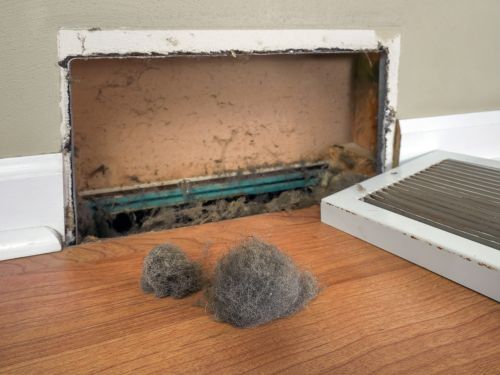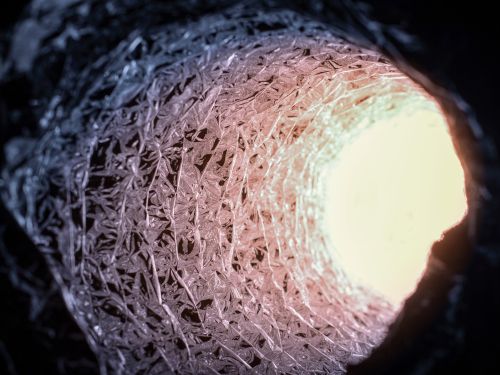Indoor air quality plays a major role in your overall health—especially for individuals who struggle with allergies or asthma. While many homeowners focus on cleaning surfaces, vacuuming regularly, and replacing air filters, one major source of indoor allergens often goes unnoticed: dirty air ducts. Your HVAC system circulates air throughout the home, and when ducts are filled with dust, mold, pollen, and other contaminants, these pollutants are pushed into every room you breathe in.
Understanding how dirty ducts affect allergies and asthma can help you take proactive steps toward improving your indoor air quality and maintaining a healthier living environment.


Why Dirty Air Ducts Make Allergies Worse
Air ducts naturally accumulate dust and debris over time. As your HVAC system pulls air in, airborne particles—including pollen, pet dander, dust mites, and mold spores—enter the ductwork. When these particles build up, they continuously recirculate throughout your home.
For those who suffer from allergies, this creates several problems:
Increased Exposure
Dirty ducts act like a reservoir for contaminants. Each time the HVAC system runs, allergens become airborne, leading to repeated exposure. This can make symptoms such as sneezing, coughing, or itchy eyes persist year-round, even when allergy season is over.
Dust Mite Growth
Dust mites thrive in warm, dusty environments—exactly the conditions inside neglected air ducts. Their droppings are a common allergy trigger and can easily become airborne through the ventilation system.
Polluted Indoor Air Quality
When ducts are filled with debris, even the cleanest home may struggle to maintain fresh, breathable air. Poor indoor air quality is linked to increased allergy sensitivity and chronic respiratory irritation.
How Dirty Ducts Impact Asthma
For individuals with asthma, dirty ducts can present even more serious issues. Asthma involves inflammation of the airways, and airborne contaminants can trigger flare-ups.
Airborne Irritants Trigger Asthma Attacks
Particles such as mold spores, bacteria, and dust can irritate the lungs, leading to wheezing, shortness of breath, or an asthma attack.
Mold Growth in Ducts
Moisture inside HVAC systems—especially near evaporator coils or in humid climates—can lead to mold growth. Mold spores circulating through vents are a major respiratory irritant and can significantly worsen asthma symptoms.
Increased Airway Sensitivity
When the air is filled with contaminants, asthma sufferers may become more sensitive over time. This can lead to more frequent inhaler use, nighttime symptoms, and reduced lung function.
Signs Your Air Ducts May Be Making Allergies or Asthma Worse
If you suspect your home’s air ducts are contributing to respiratory issues, look for signs such as:
- Musty or dusty odors when the HVAC system runs
- Visible dust blowing out of vents
- Frequent dust accumulation on furniture
- Increased respiratory symptoms indoors
- Mold around registers or inside the furnace
- Unusual spikes in allergy symptoms during certain seasons
Dirty ducts aren’t always visibly obvious, so professional duct inspections can help identify hidden issues.
Simple Tips to Reduce Allergens in Air Ducts
Improving indoor air quality doesn’t always require major renovations. Here are simple ways to reduce allergens in your ductwork and home:
Replace Air Filters Regularly
Change filters every 1–3 months depending on the type, home size, and presence of pets or smokers. High-MERV or HEPA-style filters can capture more allergens.
Schedule Professional Air Duct Cleaning
A professional cleaning removes built-up dust, mold, and debris that standard maintenance can’t. This is especially beneficial for households with allergy or asthma sufferers.
Keep the HVAC System Well-Maintained
Have your HVAC system serviced annually to ensure proper airflow and moisture control. Technicians can spot problems such as mold growth or clogged components early.
Control Indoor Humidity
Maintain indoor humidity levels between 30%–50% to prevent mold and dust mite growth. Use dehumidifiers in damp areas and ensure proper ventilation.
Dust and Vacuum Frequently
Use a vacuum with a HEPA filter and clean high-dust areas such as ceiling fans and vents regularly.
Seal Duct Leaks
Leaky ducts can pull in dust and contaminants from attics, crawlspaces, and basements. Sealing them helps prevent debris from entering the system.
Breathe Easier—Improve Your Indoor Air Quality Today
Dirty air ducts can significantly worsen allergies and asthma by circulating dust, mold, and pollutants throughout your home. By understanding the connection between unclean ducts and respiratory issues, you can take proactive steps to create a healthier indoor environment.
If you or your loved ones suffer from allergies or asthma, schedule a professional duct inspection and cleaning today with Better Air Northwest. Cleaner ducts mean cleaner air—and a safer, more comfortable home for everyone.

